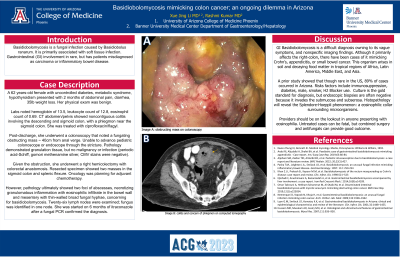Tuesday Poster Session
Category: Colon
P3149 - Basidiobolomycosis Mimicking Colon Cancer: An Ongoing Dilemma in Arizona
Tuesday, October 24, 2023
10:30 AM - 4:00 PM PT
Location: Exhibit Hall

Has Audio
- XL
Xue Jing Li, MD
University of Arizona College of Medicine
Phoenix, AZ
Presenting Author(s)
Award: Presidential Poster Award
Xue Jing Li, MD1, Rashmi Kumar, MD2
1University of Arizona College of Medicine, Phoenix, AZ; 2Banner - University Medicine Digestive Institute, Phoenix, AZ
Introduction: Basidiobolomycosis is a fungal infection caused by Basidiobolus ranarum. It is primarily associated with soft tissue infection. Gastrointestinal (GI) involvement in rare, but has been increasingly reported since 1964 in patients misdiagnosed as carcinoma or inflammatory bowel disease. Here, we present a patient who underwent right hemicolectomy for suspected colon cancer based on endoscopic findings and was ultimately diagnosed with basidiobolomycosis.
Case Description/Methods: A 61-years-old female with uncontrolled diabetes, hypertension, dyslipidemia, obesity, sleep apnea, hypothyroidism presented with 2 months of abdominal pain, diarrhea, 35lb unintentional weight loss. Her exam revealed tenderness in the left lower quadrant. She had leukocytosis to 12.8, eosinophilia to 0.69. CT abdomen/pelvis w/contrast showed noncontiguous colitis involving the descending/sigmoid colon, with a phlegmon near the sigmoid colon. She was treated with ciprofloxacin/metronidazole.
Post-discharge, colonoscopy noted a fungating obstructing mass ~ 40cm from anal verge. Unable to advance pediatric colonoscope or endoscope through the stricture. Pathology showed granulation tissue, but no malignancy or infection (periodic acid-Schiff, gomori methenamine silver, CMV stains were negative).
Given the obstructive finding, she underwent a right hemicolectomy with colorectal anastomosis. Resected specimen showed two masses in the sigmoid colon and splenic flexure.
However, pathology ultimately showed 2 foci of abscesses, necrotizing granulomatous inflammation with eosinophilic infiltrate involving the bowel wall and mesentery with thin-walled broad fungal hyphae, consistent with basidiobolomycosis. 26 lymph nodes were examined; fungus was identified in 1 node. She was started on 6 months of intraconazole after a fungal PCR confirmed the diagnosis.
Discussion: GI basidiobolomycosis is a difficult diagnosis owning to its vague symptoms, no definite risk factor, occurrence in immunocompetent host, and nonspecific imaging/endoscopy findings. Although it primarily affects the right-colon, there have been cases of it mimicking Crohn’s disease, appendicitis, and small bowel cancer. A study showed that though rare in the US, 89% of cases occurred in Arizona. Culture is the gold standard for diagnosis, but endoscopic biopsies are often negative because it invades the submucosa/subserosa. Providers should be on the lookout in anyone presenting with vague GI symptoms, non-specific colitis, and eosinophilia especially in Arizona.

Disclosures:
Xue Jing Li, MD1, Rashmi Kumar, MD2. P3149 - Basidiobolomycosis Mimicking Colon Cancer: An Ongoing Dilemma in Arizona, ACG 2023 Annual Scientific Meeting Abstracts. Vancouver, BC, Canada: American College of Gastroenterology.
Xue Jing Li, MD1, Rashmi Kumar, MD2
1University of Arizona College of Medicine, Phoenix, AZ; 2Banner - University Medicine Digestive Institute, Phoenix, AZ
Introduction: Basidiobolomycosis is a fungal infection caused by Basidiobolus ranarum. It is primarily associated with soft tissue infection. Gastrointestinal (GI) involvement in rare, but has been increasingly reported since 1964 in patients misdiagnosed as carcinoma or inflammatory bowel disease. Here, we present a patient who underwent right hemicolectomy for suspected colon cancer based on endoscopic findings and was ultimately diagnosed with basidiobolomycosis.
Case Description/Methods: A 61-years-old female with uncontrolled diabetes, hypertension, dyslipidemia, obesity, sleep apnea, hypothyroidism presented with 2 months of abdominal pain, diarrhea, 35lb unintentional weight loss. Her exam revealed tenderness in the left lower quadrant. She had leukocytosis to 12.8, eosinophilia to 0.69. CT abdomen/pelvis w/contrast showed noncontiguous colitis involving the descending/sigmoid colon, with a phlegmon near the sigmoid colon. She was treated with ciprofloxacin/metronidazole.
Post-discharge, colonoscopy noted a fungating obstructing mass ~ 40cm from anal verge. Unable to advance pediatric colonoscope or endoscope through the stricture. Pathology showed granulation tissue, but no malignancy or infection (periodic acid-Schiff, gomori methenamine silver, CMV stains were negative).
Given the obstructive finding, she underwent a right hemicolectomy with colorectal anastomosis. Resected specimen showed two masses in the sigmoid colon and splenic flexure.
However, pathology ultimately showed 2 foci of abscesses, necrotizing granulomatous inflammation with eosinophilic infiltrate involving the bowel wall and mesentery with thin-walled broad fungal hyphae, consistent with basidiobolomycosis. 26 lymph nodes were examined; fungus was identified in 1 node. She was started on 6 months of intraconazole after a fungal PCR confirmed the diagnosis.
Discussion: GI basidiobolomycosis is a difficult diagnosis owning to its vague symptoms, no definite risk factor, occurrence in immunocompetent host, and nonspecific imaging/endoscopy findings. Although it primarily affects the right-colon, there have been cases of it mimicking Crohn’s disease, appendicitis, and small bowel cancer. A study showed that though rare in the US, 89% of cases occurred in Arizona. Culture is the gold standard for diagnosis, but endoscopic biopsies are often negative because it invades the submucosa/subserosa. Providers should be on the lookout in anyone presenting with vague GI symptoms, non-specific colitis, and eosinophilia especially in Arizona.

Figure: Image A: obstructive mass on colonoscopy. Image B: colitis on computed tomography
Disclosures:
Xue Jing Li indicated no relevant financial relationships.
Rashmi Kumar indicated no relevant financial relationships.
Xue Jing Li, MD1, Rashmi Kumar, MD2. P3149 - Basidiobolomycosis Mimicking Colon Cancer: An Ongoing Dilemma in Arizona, ACG 2023 Annual Scientific Meeting Abstracts. Vancouver, BC, Canada: American College of Gastroenterology.

